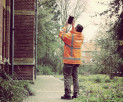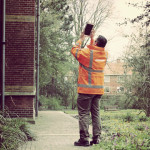Are the RUG buildings earthquake proof?
Armed with iPads and notebooks, men in eye-catching orange jackets wander through the courtyard of the Faculty of Behavioural and Social Sciences. With careful focus, they peer up at the buildings. Occasionally, they take a picture with their iPad or jot something down. They are civil engineers from Royal HaskoningDHV, on the lookout for vulnerable elements in the construction, such as chimneys, balconies, or ornaments on the buildings’ façades.
Quick visual screening
The engineers are using the Rapid Visual Screening method. Joost Smeets, project leader at Royal HaskoningDHV, says that the quick visual inspections are meant to provide a picture in short order of which elements of a building could pose a risk in the event of an earthquake. ‘The first phase of the inspection is solely concerned with the exterior. If it’s deemed necessary, we’ll also inspect inside a building, for instance when a chimney is at risk of collapsing inward.’
‘We want to map out what happens to risky elements should they come loose’
The inspection method’s name says it all: it is a quick inspection. Within the space of four hours, the civil engineers have inspected the four buildings in the Grote Rozenstraat. Mary Lammeree, coordinator for the project regarding earthquakes at the RUG, has faith that no risks will be overlooked.
‘All inspections are done by two people, so that’s two pairs of eyes going over everything. We want to map out what would happen to the vulnerable elements should they come loose from the building. If they should fall onto a patio or near an exit, there is a greater chance of people getting injured than when they fall onto private property’, says Lammeree. This first inspection is a pilot. If it is successful, all the RUG buildings will be inspected this way for seismically sensitive elements.
Drone flights
Once the inspectors have finished their check, they join Smeets and Lammeree in looking at the images captured by a drone. ‘This helps us make sure we haven’t missed anything. If it turns out that we overlooked some risky architectural feature, we’ll keep using these drone flights. If we haven’t missed anything during the pilot, those flights are unnecessary’, Lammeree explains.
The list of dangerous building elements from the inspections will be checked again at a later stage, and then double-checked by the NAM (the Dutch Petroleum Company). Lammeree hopes the NAM will ultimately cover the costs. ‘We haven’t agreed on that yet. The regulations concerning the earthquake proofing of buildings keeps changing.’






